In today’s fast-paced business world, efficiency is paramount. Companies are constantly seeking ways to streamline processes and cut costs, and one area that often gets overlooked is inventory management. Many businesses still rely on outdated methods of inventory control, resulting in excess inventory, stockouts, and ultimately, lost revenue. However, with the rise of technology and data-driven solutions, inventory optimization has become a powerful tool for maximizing efficiency and improving the bottom line. It’s a strategic approach that not only helps businesses manage their inventory more effectively but also drives significant improvements in customer service, operational efficiency, and decision-making. This approach is particularly valuable in sectors like healthcare, where medical inventory management is critical.
What is Inventory Optimization?
Inventory optimization is the process of strategically managing and controlling inventory levels to meet customer demand while minimizing costs. It involves analyzing data and using advanced algorithms to determine the optimal levels of inventory to keep on hand. This ensures that businesses have enough stock to fulfill orders without overstocking and tying up valuable resources. It’s a delicate balance that requires careful planning and ongoing monitoring. But when done right, inventory optimization can transform a company’s operations and significantly boost its bottom line, enhancing integrated healthcare systems and improving care coordination.
The Benefits of Inventory Optimization
The benefits of inventory optimization are numerous and can have a significant impact on a company’s bottom line. Here are some key advantages:
Reduced Costs
By optimizing inventory levels, businesses can reduce the costs associated with excess inventory, such as storage, handling, and insurance. It also minimizes the risk of stock obsolescence, which can be a significant expense. Furthermore, by reducing the amount of capital tied up in inventory, businesses can free up funds for other strategic investments, such as implementing a compliance management system or upgrading patient management software.
Improved Customer Service
With inventory optimization, businesses can ensure that they have the right products in stock to meet customer demand. This reduces the risk of stockouts, which can lead to lost sales and dissatisfied customers. By having a better understanding of demand patterns, businesses can anticipate customer needs and deliver a more personalized and responsive service, which is crucial in healthcare communication and patient care coordination.
Increased Efficiency
By using data and algorithms to determine optimal inventory levels, businesses can streamline their inventory management processes. This frees up time and resources that can be better utilized in other areas of the business. It also reduces the administrative burden associated with managing inventory, allowing staff to focus on more value-added tasks, such as care coordination and healthcare analytics.
Better Decision Making
Inventory optimization provides businesses with valuable insights into their inventory levels and demand patterns. This data can be used to make more informed decisions about purchasing, production, and pricing. It can also help businesses identify opportunities for growth and expansion and make strategic decisions about product mix and market positioning. In healthcare, this can lead to improved clinical pathways and integrated healthcare solutions.
Implementing Inventory Optimization
Implementing inventory optimization requires a combination of technology, data analysis, and strategic planning. Here are the key steps involved in the process:
Step 1: Collect and Analyze Data
The first step in inventory optimization is to collect and analyze data. This includes historical sales data, current inventory levels, and demand forecasts. By analyzing this data, businesses can identify trends and patterns in demand, which can help determine optimal inventory levels. It’s also important to consider other factors that can impact demand, such as seasonal trends, market conditions, and competitive activity. This comprehensive analysis provides a solid foundation for inventory optimization and supports the implementation of healthcare document management systems.
Step 2: Use Advanced Algorithms
Once the data has been collected and analyzed, businesses can use advanced algorithms to determine the optimal inventory levels. These algorithms take into account factors such as lead times, demand variability, and service level targets to calculate the right amount of inventory to keep on hand. It’s a complex process that requires a deep understanding of the business and its operations. But with the right tools and expertise, businesses can accurately determine their optimal inventory levels and significantly improve their inventory management.
Step 3: Integrate with Integrated Business Planning (IBP)
Integrating inventory optimization with Integrated Business Planning (IBP) can further enhance its effectiveness. IBP is a strategic planning process that aligns all aspects of a business, including sales, operations, and finance. By integrating inventory optimization with IBP, businesses can ensure that inventory levels are aligned with overall business goals and objectives. This alignment ensures that all parts of the business are working towards the same goals, leading to improved coordination and efficiency, particularly in care coordination platforms.
Step 4: Continuously Monitor and Adjust
Inventory optimization is an ongoing process, and it’s essential to continuously monitor and adjust inventory levels as needed. This involves regularly reviewing demand patterns, lead times, and other factors that can impact inventory levels. By making adjustments as needed, businesses can ensure that their inventory levels remain optimized. It’s also important to regularly review and update the inventory optimization strategy to ensure it remains aligned with the business’s goals and objectives.
MRO Inventory Optimization
While inventory optimization is commonly associated with finished goods, it can also be applied to MRO (Maintenance, Repair, and Operations) inventory. MRO inventory includes items such as spare parts, tools, and supplies that are necessary for the maintenance and repair of equipment and facilities. These items are critical for the smooth operation of a business, and managing them effectively can lead to significant cost savings and efficiency improvements.
The Challenges of MRO Inventory Management
MRO inventory management can be challenging due to the large number of SKUs (stock keeping units) involved and the unpredictable nature of maintenance and repair needs. This can result in excess inventory, stockouts, and high carrying costs. Furthermore, because MRO items are often used in critical operations, stockouts can lead to downtime and lost productivity. Therefore, effective MRO inventory management requires a strategic approach that balances the need for availability with the need to control costs.
The Benefits of MRO Inventory Optimization
By applying inventory optimization techniques to MRO inventory, businesses can reap similar benefits as they would with finished goods. These include reduced costs, improved efficiency, and better decision making. Additionally, MRO inventory optimization can help businesses reduce downtime and improve equipment reliability, leading to increased productivity and cost savings. It can also improve the efficiency of maintenance operations by ensuring that the necessary parts and supplies are always available when needed.
The Role of Technology in Inventory Optimization
Technology plays a crucial role in inventory optimization, as it enables businesses to collect, analyze, and utilize data in real-time. Here are some of the key technologies used in inventory optimization:
Inventory Management Software
Inventory management software is a critical tool for inventory optimization. It allows businesses to track inventory levels, monitor demand patterns, and make data-driven decisions about inventory levels. It also provides a centralized platform for managing all aspects of inventory, from purchasing and receiving to storage and distribution. This not only improves efficiency but also enhances visibility and control over inventory.
Demand Forecasting Tools
Demand forecasting tools use historical data and statistical models to predict future demand. By accurately forecasting demand, businesses can ensure that they have the right amount of inventory on hand to meet customer needs. These tools can also help businesses identify trends and patterns in demand, enabling them to anticipate changes and adjust their inventory levels accordingly.
RFID and Barcode Scanning
RFID (Radio Frequency Identification) and barcode scanning technologies enable businesses to track inventory in real-time. This provides accurate and up-to-date information on inventory levels, which is essential for inventory optimization. These technologies also improve the accuracy and efficiency of inventory transactions, reducing the risk of errors and discrepancies.
The Future of Inventory Optimization
As technology continues to advance, the future of inventory optimization looks promising. Here are some of the trends that are shaping the future of inventory optimization:
Artificial Intelligence (AI)
AI is already being used in inventory optimization to analyze data and make more accurate demand forecasts. As AI technology continues to evolve, it will play an even more significant role in inventory optimization. It can help businesses automate complex processes, make more accurate predictions, and adapt to changing conditions in real-time.
Internet of Things (IoT)
The IoT is a network of connected devices that can communicate with each other and share data. In inventory optimization, IoT devices can provide real-time information on inventory levels, demand patterns, and more. This can enhance visibility and control over inventory and enable businesses to respond more quickly and effectively to changes in demand.
Predictive Analytics
Predictive analytics uses data, statistical algorithms, and machine learning techniques to identify patterns and make predictions about future events. In inventory optimization, predictive analytics can help businesses make more accurate demand forecasts and optimize inventory levels. It can also provide insights into future trends and opportunities, enabling businesses to make more strategic and forward-looking decisions.
Conclusion
Inventory optimization is a powerful tool for maximizing efficiency and reducing costs in today’s fast-paced business world. By using data and technology to determine optimal inventory levels, businesses can improve customer service, increase efficiency, and make better-informed decisions. With the future of inventory optimization looking bright, businesses that embrace this approach will have a competitive advantage in the marketplace. As technology continues to evolve, the possibilities for inventory optimization will only continue to expand, offering exciting opportunities for businesses to improve their operations and achieve their strategic goals.








